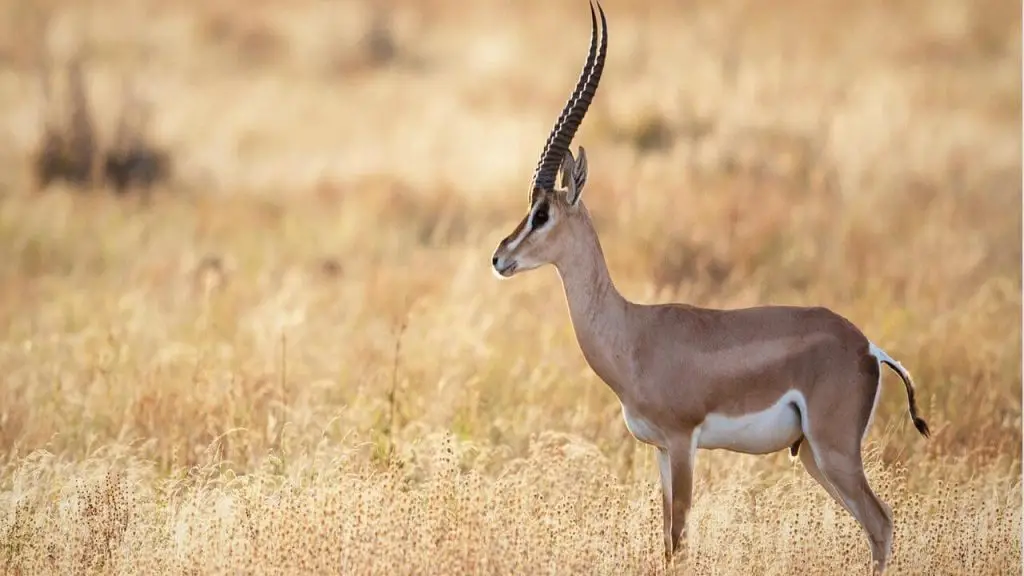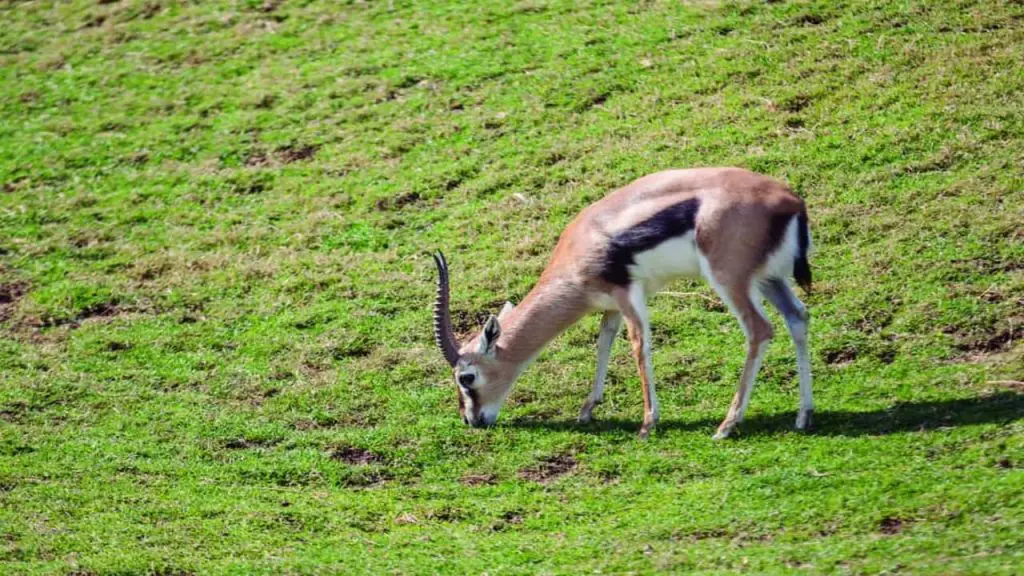As an Amazon Associate I earn from qualifying purchases.
In wide open areas with grass and dry land, where the sun shines and makes everything look beautiful, something amazing happens.
Gazelles, which are graceful and quick animals, move around with a special kind of beauty that catches people’s attention.
There are different types of gazelles, and they are good at living in different environments.
This article will talk about the various kinds of gazelles, what specifically do gazelles eat in different seasons, and how they take care of their babies.
Moreover, we’ll look at how gazelles hunt, and where they live, and share interesting facts about these amazing animals. So, let’s start and find out more.
What Do Different Types of Gazelle Eat?
1. Thomson’s Gazelle
Thomson’s gazelles, known for their love of young shoots and leaves, showcase a refined taste in grass that surprises researchers.
Studies reveal their selective grazing on specific grass types, often opting for those rich in protein or minerals.
During migrations, these gazelles cleverly take advantage of nutritional “leftovers” from wildebeest herds, ensuring they maximize their food intake while on the move.
This adaptive behavior underscores their strategic approach to eating during migrations.
2. Dorcas Gazelle
Survival experts of the savanna, Dorcas gazelles impress with their ability to adapt to various plants.
With specialized teeth and digestive systems, they fearlessly dine on thorny plants and dry vegetation, earning them the title of the savanna’s culinary adventurers.
In dry seasons, they smartly shift their diet to underground bulbs and succulents, showcasing their resourceful approach to finding food when resources are scarce.
3. Gazelle
Considered food experts, Grant’s gazelles maintain a well-balanced diet by eating a mix of grass and leaves, adjusting their menu based on seasons and habitat conditions.
In times of abundance, they savor fresh leaves, while during dry periods, they switch to nourishing grass.
Grant’s gazelles exhibit a fondness for acacia trees, munching on leaves and pods that not only delight their taste buds but also provide essential nutrients, keeping their digestive systems healthy.
4. Gerenuk
Gerenuks, with their unique long necks, utilize this feature not just for looks but to reach high leaves and fruits that other animals can’t access easily.
This special skill gives them an advantage in finding food. Gerenuks enjoy a diet of leaves and shoots, but they also have a sweet tooth, relishing the tasty fruits and pods from acacia trees, making their meals both delicious and nutritious.
5. Saharan Gazelle
Surviving in the scorching Sahara demands a unique menu for Saharan gazelles.
They rely on sturdy plants that can endure the desert’s dry conditions, such as desert grasses and succulents that efficiently store water and nutrients.
In the Sahara, finding water is as crucial as finding food, prompting Saharan gazelles to travel long distances to locate watering holes.
Their clever movements optimize their survival plan in this challenging environment.
What Do Gazelles Eat & Drink Throughout The Year?

1. Spring
A Feast for Gazelles Spring is like a big feast for gazelles! When the weather gets warmer, and after it rains, lots of fresh plants grow. This means there’s plenty of delicious food for gazelles to enjoy.
They munch on green grass, nibble on soft leaves from bushes and trees, and sometimes, if they find them, they treat themselves to juicy fruits and sweet-smelling flowers.
Because their food has lots of water in it, gazelles don’t need to drink much water during spring. It’s like a time of renewal for them, with so many different types of plants to choose from.
2. Summer
In summer, when it gets hot and the rain stops, things become dry. This affects what gazelles eat.
The soft, green grass turns tougher, but gazelles are smart eaters. They easily switch to munching on this stronger grass and trying leaves from tougher plants that other animals avoid.
During summer, gazelles must eat from trees and shrubs because these plants store water. Gazelles, like water detectives, cleverly find these green spots in the dry land.
They’re good at saving water, so they can go without drinking for a long time. If it gets very dry, they might even dig holes in dry riverbeds to find hidden water.
This shows how determined and clever gazelles are in dealing with the challenges of summer.
3. Autumn
As autumn arrives, the savanna transforms into a golden landscape, and the gazelle’s menu changes once more.
With fewer green plants, they turn their attention to fruits and seeds, enjoying the extra energy and nutrients these snacks offer.
While they may still graze on dry grasses and leaves, the variety could be less compared to the lush options available in spring.
Autumn becomes a season of adaptation for gazelles as they navigate the changing availability of food in their environment.
4. Winter
Winter can be tough in some places where it gets super cold, and there’s frost and snow. For gazelles, finding food becomes a big challenge during this time.
They have to work extra hard to get enough to eat. This might mean digging through the snow to find hidden plants, nibbling on tree bark, and looking for fallen fruits and nuts on the ground.
To handle the tough conditions, they might choose to eat plants that are stronger and can survive without much water.
Gazelles also have a clever trick – they change how their bodies work to get water from the plants they eat, so they don’t need to drink as much from outside sources.
Now that we’ve checked out what gazelles eat each year, let’s move on to something specific what baby gazelles enjoy eating.
Diet of Baby Gazelles
1. Milk Diet
When baby gazelles are very young, they start their journey by relying completely on their mother’s milk.
This nourishing elixir isn’t just a tasty treat; it’s a powerhouse of essential proteins, fats, and antibodies vital for the gazelles’ initial growth and development.
This breastfeeding routine doesn’t just last for a brief moment; it extends over several months, laying a robust foundation for the young gazelles as they take their first steps into the world.
2. Transition to Solid Foods
As baby gazelles grow up, they start trying different foods and switch from drinking milk to eating solid stuff.
This transition period is called weaning, and during this time, they eat a mix of tender grass, leaves, and shoots.
These solid foods aren’t just yummy; they give the baby gazelles the important stuff they need to make their bones and muscles strong.
3. Adaptation to Local Vegetation
Baby gazelles are like food experts—they pick what to eat based on where they live and what kinds of plants are there.
If they’re in a place with lots of green stuff, they enjoy munching on various plants.
But if it’s a dry area with little water, they smartly change their diet to include tougher, drought-resistant plants.
4. Learning from Mothers
Gazelle moms play a huge role in teaching their babies where to get the tastiest and healthiest food.
The little ones watch their moms and learn which foods are good to eat and won’t cause any harm.
This learning teamwork also makes the friendships between gazelles in the group even better.
5. Water Consumption
Having water to drink is important for gazelles, especially in areas where it doesn’t rain a lot. Baby gazelles drink their mom’s milk to stay hydrated when they’re little.
But once they start eating solid food, they need to know where to find water. Figuring out where the water is becomes an essential skill for them to live well in their home.
Baby gazelles eat in a way that helps them learn how to stay alive. They must know where to get the healthiest and safest food.
The lessons they pick up about eating early on become helpful for dealing with the challenges of living in the wild.
The Hunting Behaviors of Gazelles

Gazelles are famous for being fast and agile, but they don’t only rely on speed to stay safe in the wild.
While being quick helps them escape from predators, they have a more thoughtful plan for staying safe.
Gazelles are very aware of what’s happening around them, and they often stick together in groups, which is important for making sure they don’t become prey.
When there’s danger, they show fancy moves and talk to each other within the group. This shows they’re good at working together and not just being fast.
Their survival isn’t just about speed; it’s also about being a team and keeping a close eye out to make sure everyone stays safe in the group.
The Habitat of Gazelles
Gazelles make their homes in a diverse range of landscapes, showcasing their agility in adapting to different environments, including open grasslands, semi-arid plains, and rocky terrains.
This adaptability is a clear indication of their remarkable ability to survive in various conditions.
Gazelles prefer areas where there’s plenty of vegetation, providing them with a rich selection of grasses and plants to munch on—a crucial part of their plant-based diet.
The open spaces in their habitats not only offer abundant grazing areas but also cater to their need for quick and unrestricted movement, essential for avoiding predators.
Proximity to water sources is another defining feature of gazelle habitats, often locating them near rivers, lakes, or other bodies of water.
This strategic positioning not only meets their hydration needs but also allows them to access crucial minerals and nutrients present in the surrounding plant life.
In essence, the habitat of gazelles showcases their ability to flourish in ever-changing ecosystems, where their graceful movements and dietary choices are intricately woven into the natural fabric of their surroundings.
Now that we’ve explored how gazelles are linked to their habitats, let’s finish up with some fascinating facts about their food.
Interesting Facts About the Gazelles
1. Efficient Digestion System
Gazelles feature a unique digestive system equipped with four stomachs, a specialized arrangement that plays a key role in breaking down plant matter.
This adaptation is crucial for the thorough digestion required to extract essential nutrients from their herbivorous diet.
2. Surviving without Water
Some gazelle species, like the Gerenuk, have a remarkable ability to endure for days without drinking water.
They achieve this feat by extracting moisture directly from their food, showcasing an impressive adaptation to thrive in arid environments.
3. Team Grazing Strategy
Gazelle groups often eat together, working as a team to stay alert. This teamwork doesn’t just keep them safe in the wild; it also helps them share information about good places to eat within the group.
Conclusion
To sum it up, what gazelles eat is as interesting and varied as the places they live.
Whether it’s the green grasslands or the deserts, gazelles are good at staying alive by eating different kinds of food and adapting to their surroundings.
FAQ’s:
No, gazelles are herbivores, which means they primarily eat plants. They don’t have a diet that includes fish or other animals.
Their menu consists mainly of grass, leaves, and other vegetation.
Gazelles are big fans of grasses and tender plants. These make up the majority of their diet.
They graze on these green goodies in the open grasslands or other habitats where they live.
Their favorite foods are usually the ones that provide the necessary nutrients to keep them healthy.
Gazelles have several predators, but one of their main ones is the cheetah.
Cheetahs are known for their incredible speed and agility, making them effective hunters.
Other predators include lions, hyenas, and sometimes even crocodiles near water sources.
Gazelles use their speed and agility to escape from these predators, but they are always on the lookout for potential threats in their environment.
Amazon and the Amazon logo are trademarks of Amazon.com, Inc, or its affiliates.

